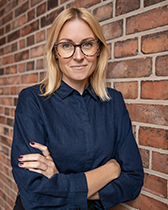Hollyamber Kennedy
Assistant Professor
Curriculum Vitae

- hollyamber.kennedy@northwestern.edu
- Kresge 4335
Where did you grow up, and where did you study?
I was born in Ojai, California, and grew up just north of there, in Isla Vista and Goleta. I later moved across the country, in high school, to live with my father in Boston, Massachusetts. I received a double B.A. from the University of Massachusetts at Amherst, an M.A. in Modern Art, Critical, and Curatorial Studies from Columbia University’s Department of Art History & Archeology, and my Ph.D. in Architectural History and Theory from Columbia University’s Graduate School of Architecture, Planning, and Preservation.
How did you develop your area of study, and how has it modified or developed?
As an undergraduate, I became extremely interested in the history of the built environment and the capacity of art and architecture to reflect and give shape to particular times and particular places, across scales. Early on, already a student of modernism, I became keenly aware of distinctions that were drawn in late 19th century historiographies between builders and architects, between informal and formal environments, and the prevailing focus on ‘settled’ or ‘landed’ populations. This evolved in my graduate studies into an interest in the architectural and aesthetic histories of migration and diaspora. Engaging decolonial heritage politics and the aesthetic, material, and environmental legacies of colonial building cultures and attendant land practices, my research now focuses on transregional links between sub-Saharan Africa and Central and Eastern Europe and investigates the ways in which architecture and infrastructure facilitated imperial governance and reshaped agrarian societies through rural modernization and resettlement projects across the 19th and 20th centuries.
Can you tell us about your current book project? What are you working on right now that excites you the most?
I am completing my first manuscript, (Un)settling Territory, which examines the visual and technical building cultures of two ministry-supported ‘settler-state’ projects in the non-aligned colonial jurisdictions of German South-West Africa, present day Namibia, and the German-partitioned states of Posen and West Prussia, in present day Poland, between the years of 1884 and 1918. This book weaves together an archive of stories about partition, about the shaping of territory, of “reclaimed” and “cleansed” landscapes, and aestheticized “frontiers” of agrarian development, while closely exploring the mechanisms—legal, conceptual, and environmental—that enabled one architectural space to be grafted over others in distinct and disparate locations. Here I unearth a decolonial terrain shaped by insurgent spatial practices, an aesthetic grammar of world-making that developed as a counterpoint to the state’s racialized land tenure and land divestment strategies. I am also in the midst of completing several major articles and book chapters for edited volumes that are helping me think through my second book project, Wastelands of Empire. This project foregrounds a concept history of waste and further develops my research focus on the historical interplay between the housing practices of large-scale land reclamation projects, land rationalization schemes under the umbrella of internal colonization, and racialized discourses of space.
What do you enjoy most about teaching?
Nothing beats the riveting experience of a fully engaged and curious classroom, when the subject matter and course materials truly resonant with the students, when they pursue that resonance and bring their own creativity of thought and diversity of experience to bear on the discussion. I am often deeply moved by their reflections, and I see how their contributions shape my approach to my own research and pedagogy. I equally appreciate the transformative influence that this kind of collaborative classroom can have on the wider world. Helping to foster a space of rigorous learning and intellectual collaboration, which supports a diversity of thought and perspective that is mirrored by diversity of experience, can transform and democratize what intellectual society looks like.
What made you particularly interested in coming to Northwestern?
Northwestern’s historic commitment to fostering challenging and rigorously interdisciplinary research, and the platforms that the University offers for the support of field-defining scholarship, were very important factors in my decision. The brilliance and generosity of the faculty and students in the Department of Art History, and the electrifying work they have authored and continue to pursue, played perhaps the most central role. It is an honor and a privilege to be a part of this amazing community of ideas.
